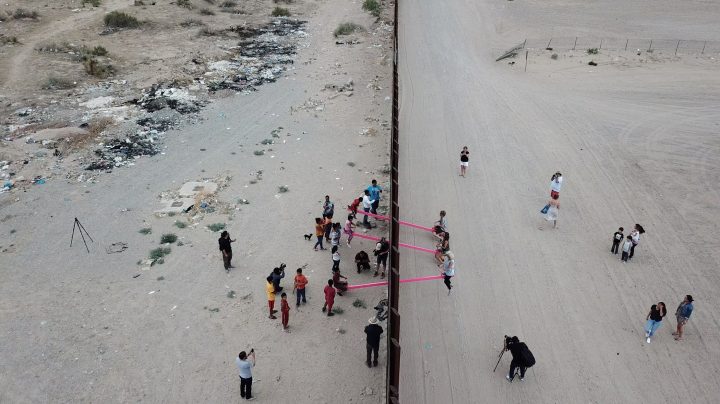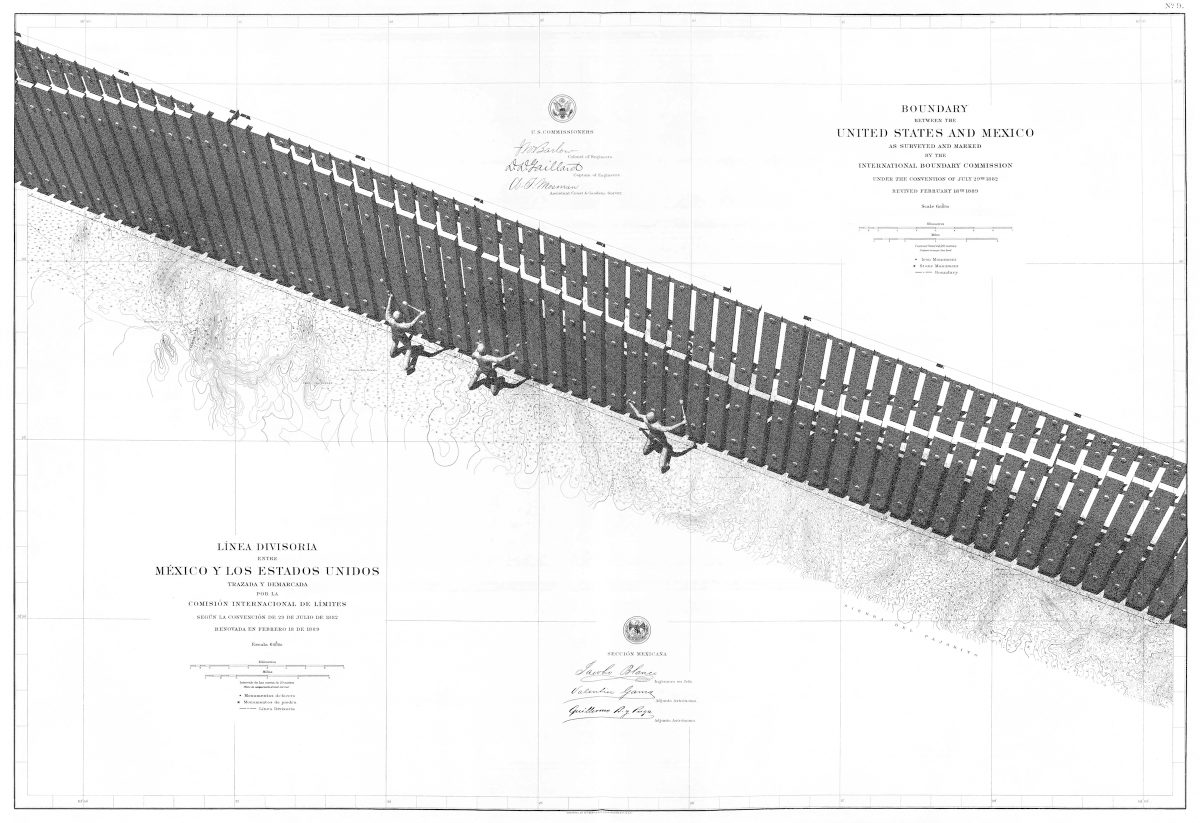
SAN FRANCISCO — On July 27, 2019, architecture firm Rael San Fratello installed “Teeter Totter Wall” at the border between El Paso, Texas and Ciudad Juárez, Mexico. The project featured three bright pink seesaws mounted between the slats of the border fence. Families on both sides took turns bouncing up and down, morphing the playground staple into a connective tool of lighthearted resistance against the divisiveness symbolized by the wall.
Despite lasting for just 40 minutes before disassembly — border patrol agents watched from afar but did not interfere — the installation went viral, and it is now the central project featured in the San Francisco Museum of Modern Art (SFMOMA)’s modest exhibition Drawing the Line: Rael San Fratello at the US-Mexican Border, curated by Joseph Becker. The works on view raise questions about the role of humor in activist art and design, how success or effectiveness should be measured in these projects, and what it means when museum board members have ties to politicians who enforce oppressive border wall policies.
As the exhibition title indicates, most of Rael San Fratello’s border interventions exist in idea only, displayed on the walls of SFMOMA as concept drawings. A grid of wall maps includes an illustration replacing the border wall with a natural boundary of densely planted cacti. Another transforms border fence slats into a giant xylophone. Nearby, small globes featuring mock-ups of the firm’s interventions are similarly satiric; one features a referee atop the fence calling a wallyball tournament, another reimagines the wall as a binational burrito stand. While there are real-world precedents for such interventions, they lack long-term feasibility, and the comically absurd nature of these concepts stems in part from their impracticality.

Here and there, allusions to the very real threats represented by the wall puncture the levity of the show. The “Cemetery Wall” globe is particularly poignant. A lone figure crouches in front of the wall, grave markers surrounding them on both sides of the barricade. The piece references the thousands of documented and undocumented deaths that have occurred at the border, as well as the destruction of Tohono Oʼodham burial sites that lay along the path of the wall’s construction.

Serious issues notwithstanding, Rael San Fratello’s border architectures largely respond to the situation with poetic playfulness, placing their work in the context of interventions like Cosimo Cavallaro’s “Cheese Wall,” Ana Teresa Fernández’s “Erasing the Border,” Rafael Lozano-Hemmer’s “Border Tuner,” Chico MacMurtrie’s “Border Crossers,” and Postcommodity’s “Repellant Fence.” These works reflect on the negative impacts of the barrier, but do not offer practical solutions for dismantling or illegally traversing it, as in projects like Judi Werthein’s “Brinco (Jump).”
Such projects bring up questions with which activist artists and designers repeatedly contend: Is it enough to highlight a problem without providing a concrete solution? Do poetry and play have a place in protest art? Does humor do a disservice to those impacted by discrimination and violence? Responses to Rael San Fratello’s works — particularly “Teeter Totter Wall” — have been divided on such issues, and I find myself seeing both sides of the argument. Humor can be a powerful tool in strategies of resistance because it gives agency to players whose stories are often told through narrow lenses of victimhood, while also frequently disarming ideological opponents. But humor can also lead to facile and forgettable reactions to concerns that deserve deeper consideration.
SFMOMA does not address such ambiguities. The exhibition text avoids reference to the more comedic aspects of Rael San Fratello’s work, rather bloodlessly describing their projects as “exercises in political subversion through design” and praising the “conceptual dismantling of the border wall.” The framing of the show seems to laud dissent and the dismantling of the wall when presented as mere exercises, operating on conceptual rather than actual levels.

Walking through the gallery, I thought about how SFMOMA hosted an Andy Warhol survey in 2019 that was organized by the Whitney Museum and partially financed by former Whitney board vice chairman Warren Kanders, whose ownership of a company that produces tear gas wielded against migrants at the US-Mexican border led to protests resulting in his resignation. Art workers in the Bay Area have since zeroed in on the activities of SFMOMA’s board, underscoring members’ donations to far-right political candidates and ties to Donald Trump’s administration. Trustee Charles R. Schwab — who served as Board Chair from 2007 to 2018 — came under particular scrutiny for donating $1 million to Trump’s inauguration ceremony and another $100,000 to his legal defense fund.
So, a museum with board members with connections to Trump — whose candidacy and presidential policies centered on his xenophobic promise to “build the wall” — is now showcasing dissent against the wall via an architectural firm whose projects are characterized as exercises in conceptual and/or temporary interventions. Presenting Rael San Fratello’s work in this way is a safe choice for SFMOMA, evincing an apparent solidarity with opponents to US border policies without ruffling the feathers of financial backers who might have balked at exhibiting works of a more antagonistic or practical tenor.
Drawing the Line: Rael San Fratello at the US-Mexican Border continues at the San Francisco Museum of Modern Art (151 3rd Street, San Francisco) through June 5, 2022. The exhibition is curated by Joseph Becker.
0 Commentaires